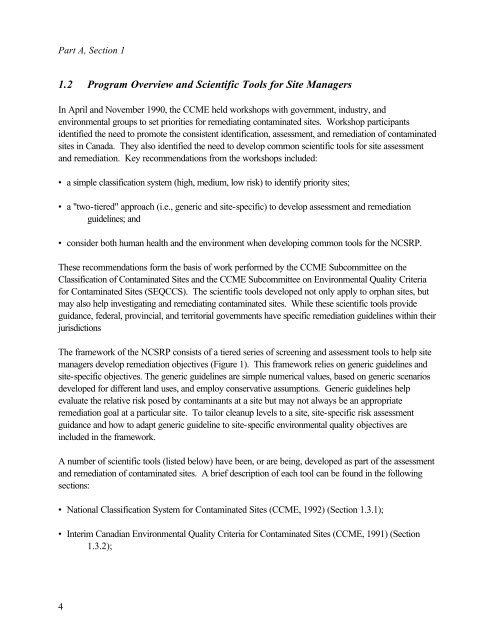Protocol for the Derivation of Environmental and Human ... - CCME
Protocol for the Derivation of Environmental and Human ... - CCME
Protocol for the Derivation of Environmental and Human ... - CCME
Create successful ePaper yourself
Turn your PDF publications into a flip-book with our unique Google optimized e-Paper software.
Part A, Section 1<br />
1.2 Program Overview <strong>and</strong> Scientific Tools <strong>for</strong> Site Managers<br />
In April <strong>and</strong> November 1990, <strong>the</strong> <strong>CCME</strong> held workshops with government, industry, <strong>and</strong><br />
environmental groups to set priorities <strong>for</strong> remediating contaminated sites. Workshop participants<br />
identified <strong>the</strong> need to promote <strong>the</strong> consistent identification, assessment, <strong>and</strong> remediation <strong>of</strong> contaminated<br />
sites in Canada. They also identified <strong>the</strong> need to develop common scientific tools <strong>for</strong> site assessment<br />
<strong>and</strong> remediation. Key recommendations from <strong>the</strong> workshops included:<br />
• a simple classification system (high, medium, low risk) to identify priority sites;<br />
• a "two-tiered" approach (i.e., generic <strong>and</strong> site-specific) to develop assessment <strong>and</strong> remediation<br />
guidelines; <strong>and</strong><br />
• consider both human health <strong>and</strong> <strong>the</strong> environment when developing common tools <strong>for</strong> <strong>the</strong> NCSRP.<br />
These recommendations <strong>for</strong>m <strong>the</strong> basis <strong>of</strong> work per<strong>for</strong>med by <strong>the</strong> <strong>CCME</strong> Subcommittee on <strong>the</strong><br />
Classification <strong>of</strong> Contaminated Sites <strong>and</strong> <strong>the</strong> <strong>CCME</strong> Subcommittee on <strong>Environmental</strong> Quality Criteria<br />
<strong>for</strong> Contaminated Sites (SEQCCS). The scientific tools developed not only apply to orphan sites, but<br />
may also help investigating <strong>and</strong> remediating contaminated sites. While <strong>the</strong>se scientific tools provide<br />
guidance, federal, provincial, <strong>and</strong> territorial governments have specific remediation guidelines within <strong>the</strong>ir<br />
jurisdictions<br />
The framework <strong>of</strong> <strong>the</strong> NCSRP consists <strong>of</strong> a tiered series <strong>of</strong> screening <strong>and</strong> assessment tools to help site<br />
managers develop remediation objectives (Figure 1). This framework relies on generic guidelines <strong>and</strong><br />
site-specific objectives. The generic guidelines are simple numerical values, based on generic scenarios<br />
developed <strong>for</strong> different l<strong>and</strong> uses, <strong>and</strong> employ conservative assumptions. Generic guidelines help<br />
evaluate <strong>the</strong> relative risk posed by contaminants at a site but may not always be an appropriate<br />
remediation goal at a particular site. To tailor cleanup levels to a site, site-specific risk assessment<br />
guidance <strong>and</strong> how to adapt generic guideline to site-specific environmental quality objectives are<br />
included in <strong>the</strong> framework.<br />
A number <strong>of</strong> scientific tools (listed below) have been, or are being, developed as part <strong>of</strong> <strong>the</strong> assessment<br />
<strong>and</strong> remediation <strong>of</strong> contaminated sites. A brief description <strong>of</strong> each tool can be found in <strong>the</strong> following<br />
sections:<br />
• National Classification System <strong>for</strong> Contaminated Sites (<strong>CCME</strong>, 1992) (Section 1.3.1);<br />
• Interim Canadian <strong>Environmental</strong> Quality Criteria <strong>for</strong> Contaminated Sites (<strong>CCME</strong>, 1991) (Section<br />
1.3.2);<br />
4
















